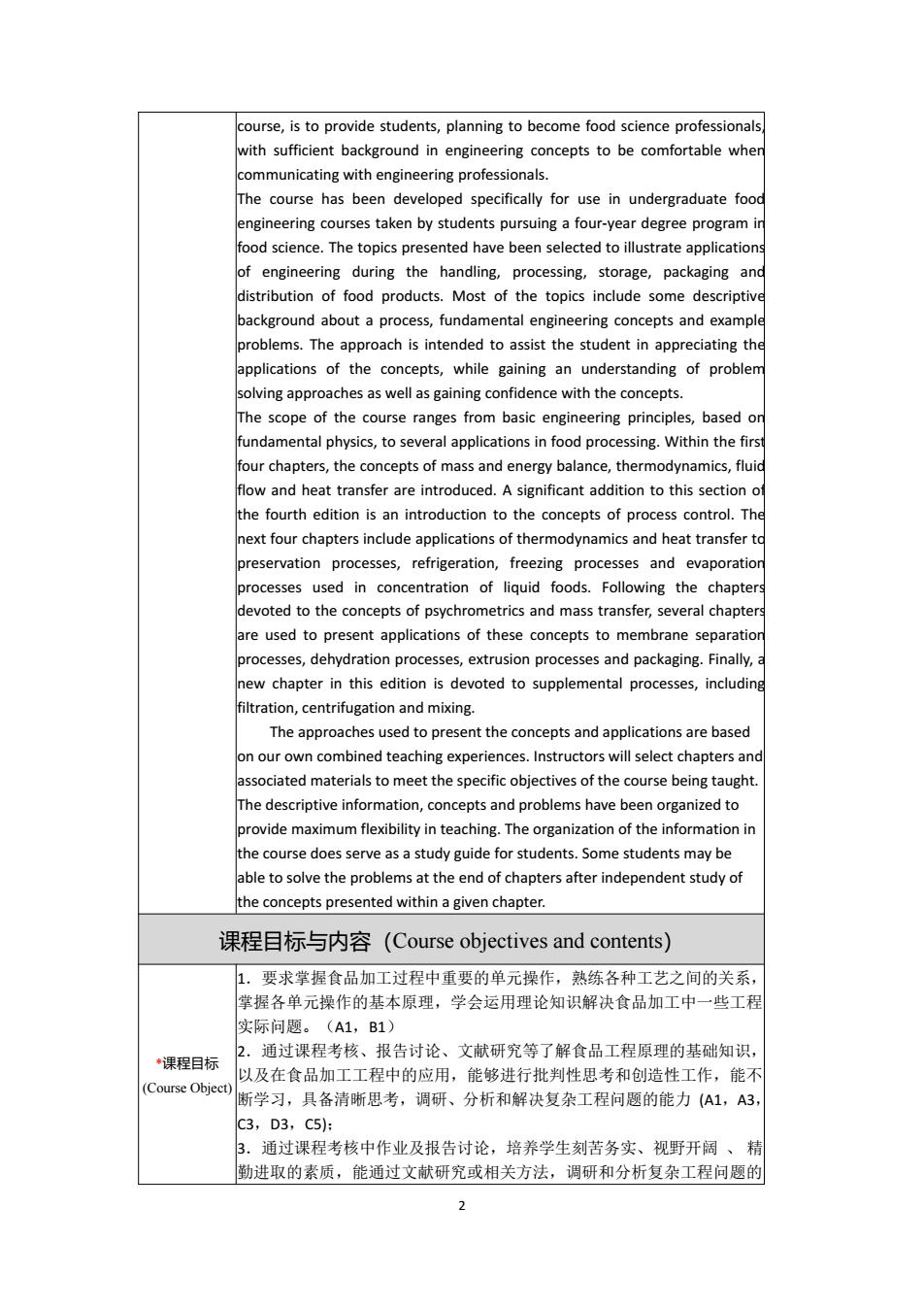正在加载图片...

course.is to provide students.planning to become food science professionals concepts to be comfortable whe The course has been developed specifically for use in undergraduate foo engineering courses taken by students pursuing a four-year degree program i food science.The topics presented have been selected to illustrate application of engineering during the handling,processing, storage,packaging an distributior f food products Most of the topic indude background about a process,fundamental engineering concepts and exampl problems.The approach is intended to assist the student in appreciating th applications of the concepts,while gaining an understanding of probler solving approaches as well as gaining confidence with the concepts. The scope of the course ranges from basic engineering principles,based fundamental physics,to several applications in food processing.Within the fir four chapters,the concepts of mass and energy balance,thermodynamics,flui flow and heat transfer are introduced.a significant addition to this section o the fourth edition is an introduction to the concepts of process control.Th next four chapters include applications of therr modynamics and heattransfer preservation processes,refrigeration,freezing processes and evaporatic processes used in concentration of liquid foods.Following the chapter devoted to the concepts of psychrometrics and mass transfer,several chapter are used to present applications of these concepts to membrane separatio processes,dehydration processes,extrusion processes and packaging.Finally, new chapter in thisedition is devoted to supplemental processes inc filtration,centrifugation and mixing. The approaches used to present the concepts and applications are based on our own combined teaching experiences.Instructors will select chapters an associated materials to meet the specific obiectives of the course being taught The descriptive information,concepts and problems have been organized to provide maximum flexibility in teaching.The the the course does serve as a study guide for students.Some students may be able to solve the problems at the end of chapters after independent study of the concepts presented within a given chapter. 课程目标与内容(Course objectives and contents) 1.要求掌握食品加工过程中重要的单元操作,熟练各种工艺之间的关系, 掌握各单元操作的基本原理,学会运用理论知识解决食品加工中一些工得 际问题。(A1.B1) *课程目标 通过课程考核、报告讨论、文献研究等了解食品工程原理的基础知识 以及在食品加工工程中的应用,能够进行批判性思考和创造性工作,能不 (Course Object 断学习,具备清晰思考,调研、分析和解决复杂工程问题的能力(A1,A3, C3,D3,C5l: 3。通讨课程者核中作业及报告过论,培养学生刻苦条实、视野开厨、 勤进取的素质,能通过文献研究或相关方法,调研和分析复杂工程问题的 2 course, is to provide students, planning to become food science professionals, with sufficient background in engineering concepts to be comfortable when communicating with engineering professionals. The course has been developed specifically for use in undergraduate food engineering courses taken by students pursuing a four‐year degree program in food science. The topics presented have been selected to illustrate applications of engineering during the handling, processing, storage, packaging and distribution of food products. Most of the topics include some descriptive background about a process, fundamental engineering concepts and example problems. The approach is intended to assist the student in appreciating the applications of the concepts, while gaining an understanding of problem solving approaches as well as gaining confidence with the concepts. The scope of the course ranges from basic engineering principles, based on fundamental physics, to several applications in food processing. Within the first four chapters, the concepts of mass and energy balance, thermodynamics, fluid flow and heat transfer are introduced. A significant addition to this section of the fourth edition is an introduction to the concepts of process control. The next four chapters include applications of thermodynamics and heat transfer to preservation processes, refrigeration, freezing processes and evaporation processes used in concentration of liquid foods. Following the chapters devoted to the concepts of psychrometrics and mass transfer, several chapters are used to present applications of these concepts to membrane separation processes, dehydration processes, extrusion processes and packaging. Finally, a new chapter in this edition is devoted to supplemental processes, including filtration, centrifugation and mixing. The approaches used to present the concepts and applications are based on our own combined teaching experiences. Instructors will select chapters and associated materials to meet the specific objectives of the course being taught. The descriptive information, concepts and problems have been organized to provide maximum flexibility in teaching. The organization of the information in the course does serve as a study guide for students. Some students may be able to solve the problems at the end of chapters after independent study of the concepts presented within a given chapter. 课程目标与内容(Course objectives and contents) *课程目标 (Course Object) 1.要求掌握食品加工过程中重要的单元操作,熟练各种工艺之间的关系, 掌握各单元操作的基本原理,学会运用理论知识解决食品加工中一些工程 实际问题。(A1,B1) 2.通过课程考核、报告讨论、文献研究等了解食品工程原理的基础知识, 以及在食品加工工程中的应用,能够进行批判性思考和创造性工作,能不 断学习,具备清晰思考,调研、分析和解决复杂工程问题的能力 (A1,A3, C3,D3,C5); 3.通过课程考核中作业及报告讨论,培养学生刻苦务实、视野开阔 、 精 勤进取的素质,能通过文献研究或相关方法,调研和分析复杂工程问题的